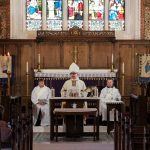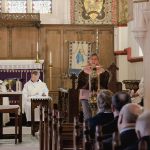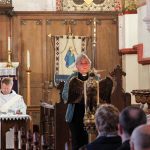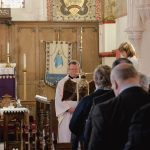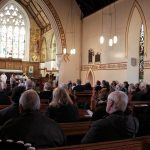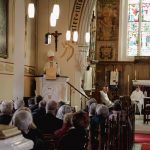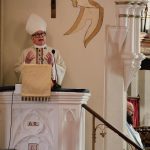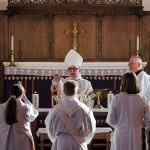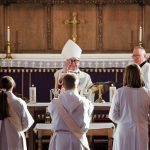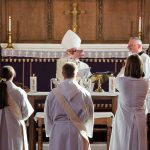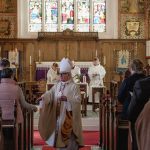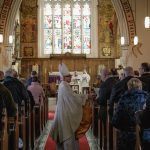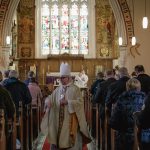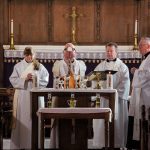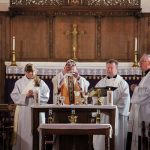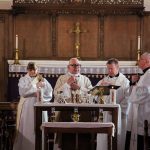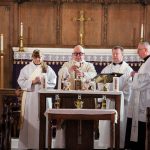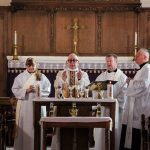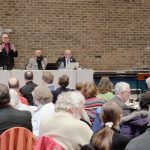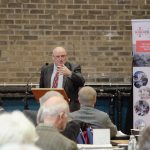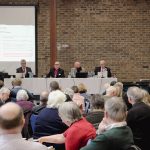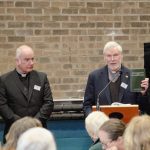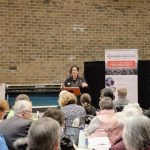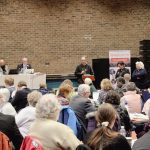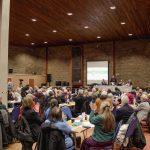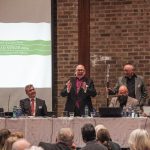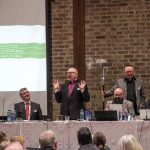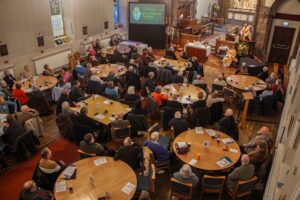Our Diocesan Synod took place on 2 March 2024, coming from Holy Trinity, Kilmarnock and the Howard Centre.
Bishop Kevin began the Synod Eucharist with the following personal announcement:
As many of you know I will retire at the end of August. At the end of June, I will give thanks to God for 45 years of ordained public ministry. I would like you all to join me at that celebration in the Cathedral on the Feast of St. Peter and St. Paul, the Feast on which I was priested. That will be my farewell service.
I came to Glasgow and Galloway four years ago, because I felt called by God to offer an episcopal ministry during a time of transition. I arrived during the Pandemic which was a challenging time for us all. With God’s help and your support: I have done my best.
I have done my best to create a strong team and foundation from which you can all move forward as one Diocese. Move forward with Trust in God and one another; with Confidence in Our Lord Jesus Christ who proved that God is with us; and with Hope – the great gift of the Holy Spirit, that we can be the change God wants to see.
Move forward with Trust – Confidence – and Hope!
The Bishop’s Charge was given during the Eucharist:
+ In the name of the Father and of the Son and of the Holy Spirit. Amen
From the Book of Genesis, the book of Beginnings:
God said – ‘Take your son, your only son Isaac, whom you love and offer him as a burnt offering.’
‘Take your son, your only son Isaac, whom you love …. Because I ask of you just one thing more.’
‘Just one thing more’ – isn’t that the experience of discipleship, the experience that everyone of us shares, the very essence of congregational life, the very essence of ordained ministry. Indeed it is, because God asks of us one thing more, but He is always seeking ways of giving to us just one thing more, the very essence of love, the very essence of what we describe in the church as Grace……
Just one thing more. Abraham was the man who had everything. Wealth in the form of herds, cattle, servants. Personal fulfilment: he was married to the woman he loved, and just one thing more, the son who would make real God’s promise of a chosen people.
Abraham felt called by God, his response to that call, a journey with God to God. Easy for Abraham because God spoke clearly to him and the angels of God spoke clearly throughout the story. The story of Abraham’s journey to the truth of who and what he was, as he wandered through the wilderness of doubt, confusion, disappointment, failure. Easy when God spoke so clearly with His angels at hand, easy to trust in God. But how do we hear God? How do we learn to trust in God? How do we journey to the truth of who and what we are?
I revert to my definition of the soul, that place deep, deep within where what I think, meets what I feel, meets what I most yearn for. That place where I am most authentically me, that place from which I feel so often there is no escape from the questions, the doubts, the struggle. Just one thing more in the story of Abraham and Isaac, out of Abraham’s bewilderment and doubt, in facing the agony of grief and the questions of the heart. There emerged a deeper, fuller understanding of and Trust in God.
Prayer, liturgy, worship, enable us hour by hour, day by day, week by week, we Trust in God in joy and exultation but – one thing more – also in grief and despair. Trust in God, in whom Our Lord Jesus Christ taught us to have confidence, which is why the portion of Philippians is read every Palm Sunday. ‘Let the same mind be in you that was in Christ Jesus,’ who in Gethsemane embraced the questions, the doubts, the disappointment, the failure. To give us, to give me confidence to embrace all those things that I would rather be without. But one thing more, that cameo of Jesus in grief and doubt in Gethsemane gives us, me, confidence to TRUST in God, who in Jesus, shows Almighty God understands you and me.
But one thing more: we trust in God, we have confidence through our Lord Jesus Christ and trust leads us to Hope, real Hope not a fraudulent optimism, ‘cross our fingers and hope that all will be well’, but the real Hope of John’s account of the wedding at Cana in Galilee. Water turned into wine, the story so familiar that we need reminding of John’s description of a Sign not a miracle. A sign not a miracle: we are always in danger of looking for the miracle that we forget to notice the one thing more, the signs of Hope in our congregations, in our Diocese in our Province of the Scottish Episcopal Church.
The real sign of the Holy Spirit active in our lives and in our church, is shown in our belief that we can be the change we want to see. There is our Hope, Hope in God in whom we trust, confidence that God is with us in our Lord Jesus Christ and God is in us through the Holy Spirit, in our belief that we can be, that we can make real, the change we want to see.
That is our real hope and a part of the work of this Synod. That is how we can build the Kingdom of God with Trust in God, shown through the confidence of our congregations that Our Lord Jesus Christ proved God is with us, if we can recognise the signs though the Holy Spirit we can be, effect, the change we want to see to bring Hope to our world.
Our congregational life has to be built on Trust. Trust in God and Trust in each other, whether small congregations or large. We all know that Trust is sadly lacking in our national and international life, but small, healthy congregations can be a sign to the world that God is with us and faith is life-giving, exciting. Only you can tell me how many times I have ended sermons with the instruction – when someone asks you on a Monday morning in the Coop – why do you go to that funny little church – tell them, witness, Trust – ‘I go because there I have an experience of the living God.’
That is how we preach the Gospel, that is how congregations grow in confidence, knowing they are being the change they want to see. Confirmations, Re-affirmation of Baptismal Promises… I have six between Easter and the beginning of June. The last confirmation I did, was of young people and the real joy in that congregation was such, that I very nearly said at the end – ‘Remember you were there the day the Great Revival began.’
And a part of our Trust in God, a sign of our confidence in Our Lord, the Holy Spirit moving to show that we can be the change we want to see. The Trust, confidence, real Hope is shown in these congregations who accept that their work is done and now is the time to celebrate and seek resurrection through dying to one particular place but seeking new life in another, that is a sign of health and Trust, Trust in the Diocese.
Who are the Diocese? It is always them, they say, but the Diocese is us. It is our Diocese, and we trust in God together that we will face the future together, confident that Our Lord Jesus Christ is with us in the sure and certain Hope that we can be the change we want to see and adapt to make real the Gospel to the communities in which we find ourselves, because we are building the Kingdom of God. One sign of the Trust and Confidence that God is with us, and we are embracing the reality of change in the power of the Holy Spirit. One sign is in the work of our Diocesan Environmental Group, in helping us address the challenge of climate change and the problems we face with our buildings and to find a way forward, confident that we are journeying forward together – there is Hope.
Ordained sacramental leadership is essential in our church and those I have instituted over the past four years, have come to help us all discover our real potential as a Diocese, to move forward. Exciting things are happening, not least in the Regions where aspiration and the vision of the Region as a whole area, with talent which can be pooled and shared, there is our real Hope, that we can be the change we want to see.
In our Province – people sigh when I give my testimony that the Scottish Episcopal Church has everything Scotland needs. Our motto Evangelical Truth – we study, preach the scriptures in the journey to the Truth of God’s Kingdom, we are not frightened of questions, doubt, God is with us. Apostolic Order in liturgy and worship: the past and the present are made one through the act of remembrance and thanksgiving, in which we are engaged, here, now, this morning. The Province should not be the enemy, there is much structural change needed but as a Province we are better together in seeking new ways of building the kingdom of God, together. Trust must be our watchword.
As I move towards leaving the Diocese, I pray that the Diocese moves forward with
Trust in God, and one another,
Confidence in Our Lord Jesus Christ who proved God is with us
And Hope – the Great gift of the Holy Spirit, that we can be the change we and God want to see.
Move forward with Trust – Confidence – Hope!
Bricks Without Straw
Bishop Kevin’s initiative, Bricks without Straw, aimed to obtain an honest picture of the reality of the charges across the diocese. Responses were sought during 2023, with 37 (out of 54) communities completing the forms. A brief summary of the findings from these returns was offered to Synod, it can be found here. As we move forward, the congregational Bricks Without Straw returns remain a helpful resource for our diocese, both in terms of assessing needs and skills and supporting ministry and mission.
Bishop’s Lent Appeal 2024
The charity chosen for Bishop Kevin’s Lent Appeal 2024 is Friends of the Holy Land. You can find more about the work and mission of Friends of the Holy Land on their website.
You can find ways to donate here and on the specially set-up fundraising platform.
Diocesan Environmental Group
Our Diocesan Environmental Group shared its 2024 focus for engaging with the Net Zero Action Plan of the Scottish Episcopal Church during Diocesan Synod. Alongside their report and presentation, the group produced a video, aiming to highlight the urgency of the climate crisis and our shared responsibility for discipleship, engagement and action. You can read the report and watch the video here.
Elections
Below are the results of the Diocesan Council election. For a full list of current Diocesan Council members check the relevant page.
The Rev Verity Brown (Pollokshields) was homologated to continue a previously vacated clergy term until its completion in March 2026, when she would be eligible for a full term, as outlined in our Diocesan Constitution.
| House | Name | Charge(s) |
| Clergy (4-Year Term) | The Rev Dawn Matthew | Challoch & New Galloway |
| Clergy (4-Year Term) | The Rev Mark Goodman | Largs |
| Laity (4-Year Term) | Mrs Jan Whiteside | Newlands |
| Laity (4-Year Term) | Dr Susan Burr | Maybole |
| Laity (4-Year Term) | Ms Morag O’Neill | Dumbarton |
Below are the results of the General Synod election. For a full list of current General Synod representatives from the Diocese check the relevant page.
Following Synod, Mr Rob Thain (Lanark) and Mrs Fiona McCulloch (Bishopbriggs) were co-opted by the Bishop’s Core Group as Diocesan Lay Representatives to General Synod.
| House | Name | Charge(s) |
| Clergy (4-Year Term) | The Rev Debbie Davison | Paisley & Hillington |
| Clergy (2nd 4-Year Term) | The Very Rev Reuben Preston | Renfrew & Johnstone |
| Laity (2nd 4-Year Term) | Mrs Jan Whiteside | Newlands |
| Laity (4-Year Term) | Mrs Jenny Whelan | Newlands |
Below are the results of the Alternate Representatives to General Synod.
Lay
Mrs Hilary Moran – Largs
Mr Paul Hindle – Lenzie
Mr Richard Horrell – Helensburgh
Mr Richard Smith – Helensburgh
Clergy
The Rev Cn Gordon Fyfe – Newlands
The Rev Dawn Matthew – Challoch & New Galloway
The Rev Dr Lisa Curtice – Renfrewshire
The Rev Dominic Ind – Helensburgh
Below are the results for the Provincial Panel for Episcopal Elections
Mrs Nicolette Wise (Lay)
The Rev Cn Gordon Fyfe (Clerical)
Resolutions
Formally proposed as a Resolution for General Synod on Behalf of the Diocese of Glasgow and Galloway, the motion for this Resolution to be forwarded was proposed at our Synod by the Very Rev Kelvin Holdsworth and seconded by the Very Rev Reuben Preston.
That this synod
•recognises that there needs to be greater flexibility in clerical appointments than the current canonical structures provide and
•recognises that there needs to be a more appropriate canonical provision for congregations which are not incumbencies than the current canonical structures provide and
•requests that the Faith and Order Board bring proposals to the General Synod in 2025 to address these matters.
The following five resolutions (Liturgical Motions 1-5) regarding new liturgies were proposed at our Synod by the Very Rev Kelvin Holdsworth and seconded by the Rev Canon Oliver Brewer-Lennon.
LITURGICAL MOTION 1
That this synod welcomes the intention to introduce services for Lent and Holy Week which reflect the language of the 1982 Liturgy (Revised). Given this declared intent, it is the mind of this synod to request that the Lenten themes of the 1982 Liturgy and Daily Prayer are incorporated into the introduction to the season by making a change to the proposed address at the start of Lent as follows:
Replace the following:
Dear friends in Christ, as we begin the season of Lent we are reminded that, in our Christian lives, we seek to realise the death of Jesus so that God may be glorified in our worship and through our witness in the world. Saint Paul writes of ‘carrying around the death of Jesus in our bodies, so that the life of Jesus may be clearly shown in our bodies’ (2 Cor 4. 10). It is through baptism that we die into Christ’s death (Rom 6. 3– 4) so that we may share in his resurrection. In beginning our Lenten observance, we are therefore reminded of our baptism, and how Christ’s death on the cross may clearly be shown in our lives. We now come before God in penitence, reflecting on our life in Christ. We pledge ourselves to observe this season of selfexamination, discipline, and self-denial with sincerity, prayer, and reverent reflection on holy Scripture, seeking God’s purpose for us, and modelling our lives on the example of Christ Jesus.
with a text such as this:
Dear Friends in Christ, it is the custom of Christian people to prepare to mark the time of Christ’s passion and resurrection by a season of penitence and fasting.
The church calls each of us during these forty days to repent of all that causes harm to ourselves, harm to our earthly dwelling place and harm to our relationship with God.
By carefully keeping these days, Christians take to heart the call to repentance and the assurance of forgiveness proclaimed in the gospel, and so grow in faith and devotion. In turning our hearts towards God, we discover anew the boundless grace of God.
For God will help us to create beauty even within the turmoil of this chaotic world and will help us to gather a harvest of joy and gladness from lives of sorrow and care. Today and every day, God calls the wandering exile home.
We are invited therefore, in the name of the Church, to the observance of a holy Lent, by self-examination and repentance; by prayer, fasting, and self-denial; and by reading and meditating on God’s holy word.
LITURGICAL MOTION 2
That this synod recognises that the call to repentance is to the whole world and not simply to those who are baptised. In recognition of this, and aware that the church often includes those who are seeking baptism as well as those who have already been baptised, this synod requests the use of more inclusive language at the imposition of Ashes as follows:
Replace:
I invite you to receive the mark of Christ’s cross,
with which we are signed at Baptism,
and by which we are forgiven our sins
and live to the glory of God.
with a text such as this:
I invite you to receive the mark of Christ’s cross,
our symbol salvation,
and live to the glory of God.
LITURGICAL MOTION 3
That this synod requests language that is inclusive of those who are yet to be baptised be used at all points during Lent and Holy Week and specifically at the distribution of Palms and that the language of the Palm Sunday liturgy does not confuse the Palm Sunday procession with walking the way of the Cross.
Thus, replacing:
Almighty and everlasting God, may these palms [and branches] be for us a sign of Christ’s victory over sin and death; and may we who have been baptised in his name, worship him as king, obey him as Lord, and follow him in the way of the Cross, which leads to eternal life. We ask this through the same Jesus Christ our Lord.
with a text such as this:
Eternal God, may these palms [and branches] be for us a sign of Christ’s victory over sin and death; and may we worship him as king, obey him as Lord, and follow him with joy. We ask this through the same Jesus Christ our Lord.
LITURGICAL MOTION 4
That this synod
•welcomes the recognition in the Maundy Thursday liturgy that we are all made in the image of God and
•acknowledges that the recognition that every person is made in the image and likeness of God has given dignity to the human condition and has directly led to many different aspects of the modern human rights movement including recognising the full and equal humanity of men and women, LGBT people and people of colour.
•For this reason, the synod requests that the new liturgy does not also use language that could seem to suggest that the image of God that every person bears, might be marred, spoiled or removed.
Thus, replace:
Do you repent of the sin which has separated you from God, and marred God’s image in you?
with a text such as this:
Do you repent of the sin which has separated you from God?
LITURGICAL MOTION 5
That this synod request that the invitation be given either to refrain from receiving communion on Good Friday or to receive communion from the reserved sacrament but that there be no encouragement in the liturgy to hold a full Eucharist on that day.
Opinions
Opinions from Diocesan Synod on second reading for Liturgy (in 2024 the Liturgies for Lent, Holy Week and Easter)
There was a very lengthy discussion on these second readings for the Liturgies, and strong feelings were expressed that, although Synod applauded and appreciated the valuable work that had gone into them by the Faith and Order Board, there were certain areas that could be made better to ensure that our Liturgies are fully inclusive and accessible. Although opportunities had already been offered for feedback, it was strongly felt that the opportunity to make further improvements should be taken before the second readings were passed, hence the Five Liturgical Resolutions/Motions above, on which votes were taken.
Motion 1: In favour 50, Against 7, Abstentions 20.
Motion 2: In favour 52, Against 9, Abstentions 16.
Motion 3: In favour 31, Against 19, Abstentions 29.
Motion 4: In favour 53, Against 5, Abstentions 23.
Motion 5: In favour 13, Against 37, Abstentions 28.
Opinions from Diocesan Synod on Canons 15, 16, 35 and 65
Canons 15 and 16: upon seeking comments regarding both Canons, the view was that although the Canons had many positive attributes, they were ‘not ready yet’. There were concerns that we were inviting people from other denominations to take services when we are not in full communion with them. Frequent reference was also made to safeguarding issues which allowed clergy from other denominations to be admitted to our system without having gone through our own safeguarding protocols, and it was felt that Synod should say no to the Canons in their current form. Much debate ensued, with strong support of these views expressed, most especially with regard to the fact that the safeguarding issues did not seem to have gone before the Provincial Safeguarding Committee. So although there were suggestions from some that General Synod should take the Canons forward to a Second Reading with the request ‘that they be updated’, it was pointed out that Synod was being asked to approve them for a Second Reading or not, and that we needed to say ‘no’ out of love and encouragement to get the Canons right.
Accordingly, a vote was taken to establish whether Synod Members were willing to have these Canons considered for a Second Reading by General Synod.
The result of this vote was strongly against taking Canons 15 and 16 to a Second Reading (For: 5; Against: 67; Abstentions: 7)
Canon 35: although there was extremely strong support for the philosophy behind the amendment to Canon 35, there was significant apprehension about the practicality of ‘adhering’ to the Net Zero Guidance endorsed by the Provincial Buildings Committee, which many charges felt was too prescriptive and, if fully enacted, would simply not allow their charges to survive as it would be impossible to completely adhere to these requirements due to the various constructions and limitations of their buildings. In short, some slight room for leeway was felt to be essential.
A motion was raised, “That this synod votes to replace the words ‘adheres to’ in the proposed Canon 35.1 with the words bears in mind or must take account of” so that the new sentence would read
provided always that such approval bears in mind or must take account of the Scottish Episcopal Church Net Zero Guidance endorsed by the Provincial Buildings Committee
Two votes were taken on this matter, the first to confirm that Synod agreed to this amendment (Clergy in favour 34, Against 1, Abstain 0; Laity in favour 41, Against 3. Abstentions 2, and the second to confirm that Synod was only in favour of passing the 2nd Reading with the amendment in place (Clergy in favour 33, Against 0, Abstentions 1; Laity in favour 43, Against 1, Abstentions 1).
Canon 65: Synod was in full agreement with Canon 65 going forward to a Second Reading (Clergy in favour 32, Against 0, Abstain 0; Laity in favour, 46, Against 0, Abstentions 1)
Photographs
___________

